
Seo Keyword research for an online ecommerce Store
Table of Contents
If you’re not familiar with keywords and their role in the online world, they are magical little words or short phrases that search engines like Google, Bing, Baidu, DuckDuck Go, and others use, to find and display the most relevant search results.
What Is Keyword Research & Why Is It Important for eCommerce SEO?
Keyword research is how you find every possible search engine query, relevant to your eCommerce store and your customers.
Finding & organising relevant keywords is decidedly the first step for building an online e-commerce store. When you do this right – it allows you to find category, sub-category, product-related keywords, and questions – that your target audience is typing into Google.
Among the three most important Search Engine Optimisation (SEO) factors, effective Keyword research takes the number one position.
The other two factors – content marketing and link building – are also crucial for the success of your ecommerce brand. But you can only build effective content marketing and link-building strategies based on uncovering the best keywords for your online store.
E-commerce keyword research improves and expands website content, leading to higher rankings for primary keywords and a wider range of long-tail keywords. This, in turn, drives relevant organic traffic to your online store, ultimately achieving your business goals.
Is There a Difference Between Ecommerce SEO Keyword Research And Traditional Keyword Research?
Traditional keyword research is aimed at understanding the overall ‘search query’ landscape related to your niche, not just finding keywords with immediate purchase intent.
This involves answering your user’s questions, helping them make a decision and becoming a valuable educational resource in your niche. Over time, this approach may lead to indirect sales, but the primary goal is to share knowledge and create strong brand awareness.
Keyword Reseach for retail eCommerce prioritises sales. So, the primary goal is to find keywords that highlight a searcher’s immediate purchase intent and optimise corresponding pages.
Should retail ecommerce websites focus on traditional keyword research at all?
Yes, they should. User journeys are complex. On average, it takes a minimum of 7 touchpoints for someone to trust your brand and buy from your website.
Answering questions that come up during a user’s purchase journey positions your business as an authoritative source, and builds overall topical coverage for a product category. This, in turn, helps you rank higher, even for transactional searches.
What Are The Overall SEO Benefits Of Keyword Research For ecommerce Sites?
Keyword research plays a decisive role in ecommerce SEO. The reason is keywords help with the following:
- Identifying the target audience of your ecommerce store and communicating with them in their language
- Creating compelling content for your audience, targeting different points in the user’s journey
- Getting the most relevant content – content that can convert – in front of the right person at the right time
- Boosting search engine rankings by building topical authority for your product categories & sub-categories
- Driving the most relevant traffic to the appropriate webpage on your ecommerce store
- Increasing the time spent on your business website by ensuring only the most qualified visitors arrive at your store
- Increasing conversions by helping potential buyers find your ecommerce store easily, instead of your competitors’ stores
What Factors Should You Consider When Doing ecommerce SEO Keyword Research?
You need to consider various factors while doing e-commerce SEO keyword research. Let’s examine the most relevant ones.
1. Keyword Volume
Keyword volume, also known as keyword search volume, denotes the number of searches for a keyword over a selected timeframe (typically a month). You can pull this number for free from several third-party SEO tools such as Google Keyword Planner, Moz, WordTracker, SearchVolume, etc.
Paid SEO Keyword Research Tools include the likes of SE Ranking, Mangools, Moz and Ahrefs.
Bear in mind that the volumes indicated by both free & paid SEO tools is only an approximation. You never get an accurate number. This number usually indicates an average value based on the previous 12 months.
Some keywords may have an insignificant or zero search volume. These “zero-volume keyword phrases” are highly granular, and can drive buyers with high purchase intent. This is especially true if you’re operating in a relatively less known or brand new niche.
2. Query Relevance
The chief goal of an eCommerce site is to make a sale. That is, you want the visitor to your online store to buy something. So, it’s vital that you choose keywords that your audience is searching for and that match your products.
For instance, imagine you’re selling Home furniture and want to target customers in different stages of the buying funnel.
You must choose relevant keywords in your primary niche such as “furniture for home” and associated product-category keywords.
Additionally, shortlist related, low-competition keywords such as “home improvement tips” or “home improvement tools”. Due to a lower SEO difficulty score, they will be easier to rank for in search engines.
3. Ranking Difficulty
In the SEO universe, ranking difficulty is a handy metric. This value tells you how difficult it may be to rank for a specific search query. This SEO factor is important because it helps you determine the right keywords to target.
Keywords are broadly classified into Head/Short-Tail (One or two-word phrases with high competition) and Long-Tail Keywords (Greater than three-word long phrases with relatively less competition).
So, before you pick a keyword, you need to first understand how many people are searching for it. Also, you need to understand the level of competition for this keyword and the number of sites that are targeting the keyword.
Even if you decide to choose a highly competitive keyword, you may not be successful in ranking high enough to attract more visitors, atleast initially. As a result, the organic traffic for this keyword may be low. Or, you may get unqualified organic traffic.
Actually, until you have built sufficient authority with the search engines, your web page is likely to rank on the second page of Google or beyond for super-competitive keywords.
From a Business perspective, few genuine buyers have the patience to check vendors on the second page or beyond. The ones who do may be looking for something very specific.
They may be bottom-fishing bargain hunters or simply exploring options. As a result, sales lead conversions and the return on your SEO spend may be low. Some battles are simply not worth fighting.
Hence, the recommended approach is to use a mix of short (competitive) and long-tail keywords
4. Seasonality
Seasonality is a key traffic driver for an ecommerce store.
Weather, holidays, and dates impact peoples’ buying decisions in a big way. It’s a given that seasonality impacts all businesses, regardless of location, product, or service. You can generate higher sales when you adopt a seasonal SEO marketing strategy. You’ll simply need to focus on engaging your target audience based on natural changes in their behaviour.
A seasonal SEO strategy explores different ways to drive conversions. You stay alert to various themes or a specific period of time.
The two major types of Seasonal SEO strategies are Time-based and Event-based.
Summer, Winter, and certain months fall under a time-based SEO strategy.
Thanksgiving, Christmas, Bank Holidays, Black Friday, New Year, and National Holidays fall under an event-based SEO strategy.
In any given year, a retail business experiences highs and lows. Your seasonal products need a push to reach more leads – exactly when they want to buy. So, you need to understand the business cycle of your ecommerce store and plan your SEO strategy accordingly.
USEFUL TIP: Google Trends can help you find the right time when demand peaks for your product.
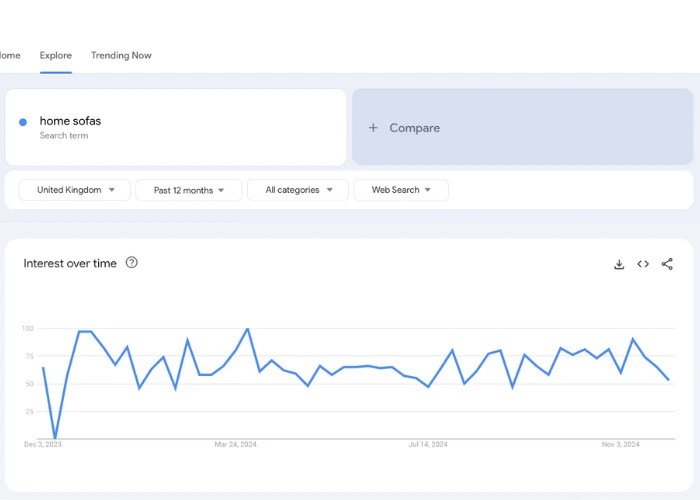
5. Word Variations/Spellings for International Stores
Search engines have evolved beyond exact keywords or clever targeting of misspellings. So, you can focus on having a single keyword theme – either US or UK English – as opposed to different themes for different words.
Search Engines understand the subtleties of human speech and intent. This evolution is reflected in keyword research.
Do consider the fact that searchers do visit online ecommerce stores that cater to other geographies. They do this to buy products that are not available in their country’s ecommerce stores, or because the online store in question has an international presence.
If you’re a store interested in targeting an international audience, make sure to understand specific language differences in terms of local keyword variations. This is especially true for niche ecommerce Stores.
6. Search Intent
Search Intent refers to the “why” behind a user’s search. Are they looking for an answer to a question? Seeking more information on a topic? Do they want to visit a specific Brand’s website? Do they want to buy something?
Search Intent may be classified into two broad types:
- Informational – User is seeking guidance or help from the Search Engine.
This may be in the form of an answer to a question, understanding a topic in more depth, more information on a brand, a need to navigate to a website or physical location or to find a product/service close to their location.
- Commercial – User is interested in buying a product or service
The main goal of any ecommerce site is to sell more of what they have. So, their core SEO keyword focus should be to maximise for Commerical Intent keywords, while building their informational keyword stack through Blog and Informational Pages.
7. Keyword Density
Keyword Desity is the frequency with which a keyword-phrase appears on a given page. Google algorithms may penalise your content as spam if the density is very high.
So, what’s the optimum keyword density & why does it matter? 1–2% is a reasonable value for SEO Keyword density. This means your keyword will appear once or twice every 100 words.
The easiest way you can create content with optimal keyword density is by focusing on the needs of your readers first. You can then tweak the content – if necessary – to let the search engines take note of your content.
8. Competitor Analysis
Understanding your competitors’ strategies and keywords can reveal low-hanging opportunities and gaps. Using this information effectively, in turn, can improve your search engine rankings.
Here’s how to conduct competitor keyword analysis:
1. Identify your competitors
- Direct competitors: These are businesses that sell identical products or target the same audience as your business. For example, if you sell running shoes, Nike, Adidas, or Asics are your direct competitors.
- SERP competitors: Websites ranking for your target keywords, even if they don’t sell the same products. For example, a blog reviewing running shoes could be a SERP competitor even if it isn’t selling shoes.
2. Analyse Their Keywords
Once you’ve identified competitors it’s time to analyse their keywords. Use SEO tools like Ahrefs, SEMrush, SERanking, or the Google Keyword Planner (free).
The process is quite simple, once you add competitor URLs into these tools, they will extract the keyword data. With this data, you’ll be able to find insights such as:
- Keywords your competitors rank for
- Keywords driving their traffic and conversions
- Their seasonal or promotional terms
- Their top performing pages and content strategy
- SERP features (featured snippets) they’re ranking for
This business intelligence enables you to refine your SEO strategy, outperform competitors, and boost conversions.
How Should You Do Keyword Research For Your ecommerce Store?
You need to consider various factors while doing e-commerce SEO keyword research. Let’s examine the most relevant ones.
Step 1. Decide The SEO Tools You’ll Use For Research
Good SEO tools will make a skilled SEO professional better. There are various options in the market – Free/Freemium and Paid.
Free/freemium/paid SEO Tool Recommendations:
Google Keyword Planner
Originally Google Ads Keyword Planner, this tool helps you determine the right keywords to target with SEO. Although this tool is free, the search volume analysis is quite exhaustive. Let’s use “Home Sofas” as an example category.
As evident from the image below, you get only the approximate ranges, but nearly 856 keyword ideas. There is also a Beta version showing several modifications and filters. Nice! However, unless you’re using Google Ads as part of your Marketing strategy, it’s not easy to easily access this keyword planner tool anymore.
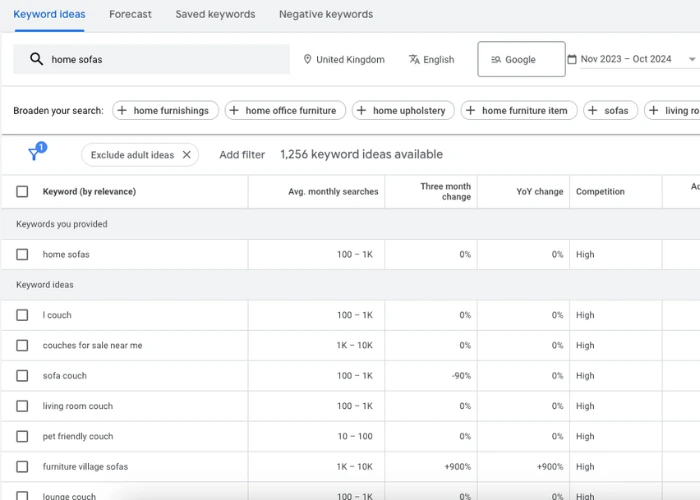
Ubersuggest
Ubersuggest gives you a lot of insight into the strategies your competitors are using. Let me explain. Look carefully at the image below. You get a clear idea of their social media marketing and content marketing strategy. Hence, it’s easy to gain an edge over your competitors when you use Ubersuggest in your eCommerce SEO keyword research. You only need to adapt their methodology and improve them. The keyword suggestions and content ideas that Ubersuggest presents you with are very useful.
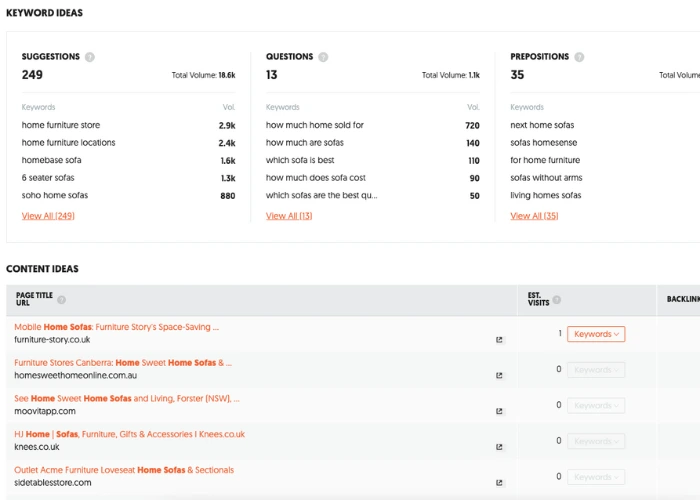
Free Keyword Research Tool Recommendations:
Google Autocomplete Suggestions
Google Autocomplete is a feature that presents you with search term predictions on the Google search bar. For instance, if you type “Home sofas” into your Google search bar, this is what you see:
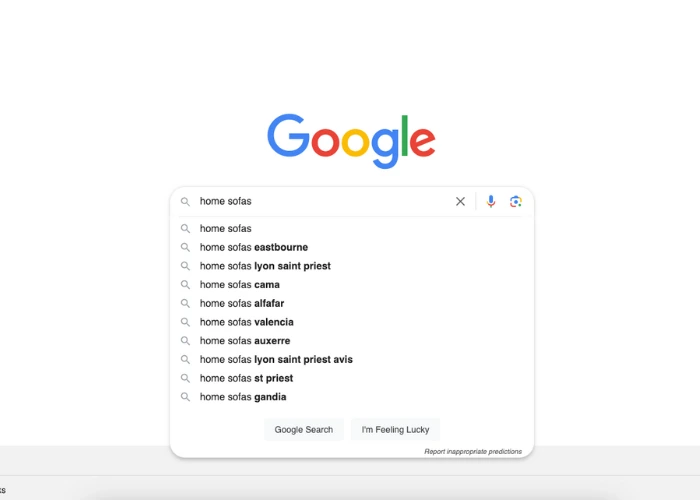
Google Search Console Data
Google Search Console is free for anyone maintaining a website. This tool keeps tabs on the performance of your website. The valuable insights you get from Search Console permit you to see which keywords are driving visitors to your site and which segment of your site needs work.
You can enter the most important URLs on your ecommerce site, one at a time, and get a list of keywords you’re already ranking for, along with their ranking positions.
This list is a very valuable resource, which you can use to further optimise pages for certain money/commercial keywords that you may already be ranking for, on the 2nd, 3rd, and any subsequent pages of Google.
Sometimes, a specific keyword may need attention. The impressions may be decreasing or the ranking may be slipping. The Search Console Report is an easy and free way to find, review, and track your keywords over time.
Amazon Data
The Amazon Keyword Tool is immensely helpful in keyword research for ecommerce. You get a clear perspective of what people look for when they visit your ecommerce store. Remember, your product titles and descriptions need to be short, sharp and to the point.
Remember, people are looking for shortcuts all the time. When they’re shopping, they only scan the product titles, features, and so forth. Hence, your prime keywords need to be the ones that people are searching for a lot. The image below will give you a fair idea of what people look for in an online store.
The predictions will change and adjust as you continue typing. You can use Google Autocomplete in keyword research to find long-tail keywords in your niche.
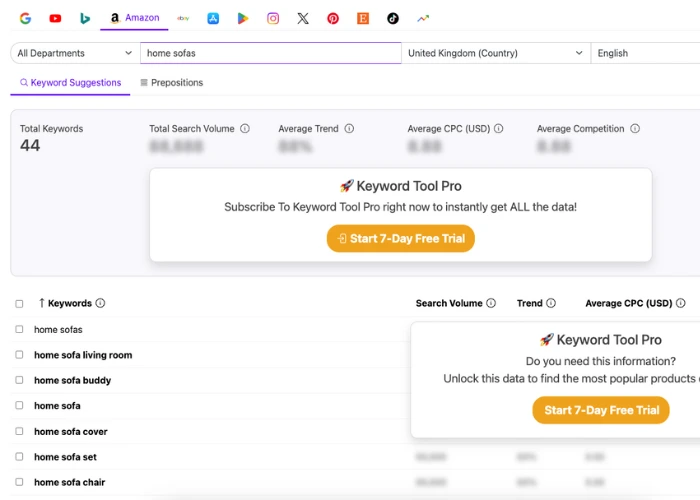
Paid Keyword Research Tool Recommendations:
SE RANKING
SE Ranking is a value-for-money ecommerce SEO keyword research tool. Their exceptional rank tracking, smart reporting tools, and updated user interface prime you for business success.
You can sign up for their 14-day free trial without a credit card. I have found their user interface far more user-friendly than some of the other paid tools. But on the flip side, the market intelligence with regard to competitors is more limited.
SEMRush
SEMrush, an all-purpose SEO tool, was launched in 2008. An extremely popular industry tool, their pricing may seem a bit steep for smaller businesses & freelancers. However, you can count on their solutions to provide valuable business intelligence. This in turn helps drive more traffic and more sales to your ecommerce store.
AHREFs
Ahrefs, launched in 2010, is another all-purpose SEO tool. This tool can help you with keyword research, website audit, content marketing, and more. The Ahrefs Keyword Explorer tool can help you with important keyword metrics such as keyword difficulty and search volume.
Step 2. Gather Your Top Category Keywords
Any Micro, Small, or Mid-sized ecommerce Business will have anywhere from 5-20 core keywords. These may also be referred to as main category or parent keywords.
Each of these core keywords will then have a cluster of hundreds of queries. These are usually the sub-categories or product-related keywords.
Your focus should be to optimise your online store for both the core or parent/category keywords as well as child/sub-category keywords.
Example – For a Living Room Furniture Store, the core keywords could be Sofas, Coffee Tables and Book Shelves
Step 3. Find The Cluster/Sub-category & Product Keywords
For every Core keyword there can be hundreds of sub-category keywords. Depending on your site niche, you may be able to target only a selection of such keywords.
Example – For the Core Keywords in Step 1, the Sub-category Keywords may be as follows:
Sofas – Corner Sofas, Designer Sofas, Leather Sofas
Coffee Tables – Wooden Coffee Table, Marble Coffee Table, Modern Coffee Table
Book Shelves – Corner Book Shelf, Hanging Book Shelf, Metal Book Shelf
Further, product-related keyword searches would go a level deeper and usually add additional attributes such as brand name, color, size, and so on.
Example – “<XYZ Brand Name><Color> Corner Sofa <Additional Atrribute>” ~ Ikea Black Corner Sofa 3 Seater.
Step 4. Aggregate Your Keywords
Once you have generated a list of organic keywords that are relevant to your ecommerce store, categorise, sort, and group them.
Put a relative value against each keyword beyond just search query volume. Take into account ranking difficulty and seasonality, too.
All keywords are not equal. Sometimes, low-volume keywords can be far more relevant and lucrative than high-volume keywords. The reason is low volume keywords are far more specific and highly likely to result in a conversion.
Step 5: Conduct Keyword Mapping
You can map your ecommerce money keywords in two useful ways:
A. Map it by User Journey (Top/Middle/Bottom Funnel)
The acronyms “Top of Funnel” (TOFU), “Middle of Funnel” (MOFU), and “Bottom of Funnel” (BOFU) refer to the various stages of a user’s journey. You really need to have a thorough understanding of your business to determine the keywords that you can categorise under each one of these stages.
Why map your keyword data by User Journey?
Grouping your keywords under each one of these stages enables you to deliver more relevant content to your target audience. And this point is critical because it improves your conversion rate. Here’s an example of keyword mapping based on the user journey:
- TOFU: what is trail running shoes -> you can create content that introduces trail running shoes in general
- MOFU: trail running shoes for beginners -> you can create content that recommends some trail running shoes for beginners
- BOFU: nike trail running shoes -> you can create content that is more brand specific
B. Map By Intent (Commercial/Informational)
As mentioned earlier in this article, Searcher Intent is the “why” behind a User’s Search.
Review your Keyword Sheet and map keywords based on a User’s intent to either buy a product or seek further information related to a category/sub-category or product.
How Should You Use Keyword Research To Optimise For ecommerce SEO?
Now that your keyword list is ready, it’s time to use them on your ecommerce site.
The good news is keyword stuffing does not work any more. Hence, the best approach is to optimise every single product and category page, using a focus keyword for each page. You can then include long-tail keywords & other keyword variations in the page content.
Try to assign the most important keywords that already drive sales, and which are likely to drive additional traffic through your SEO efforts, to pages that are higher in your site hierarchy.
That probably means your most important pages such as the Home Page and the Top Level Category Pages.
In addition to being in the copy on the page, you should aim to include keywords in several other key places namely the Title tag, Meta Description, H tags, and finally Image Alt tags.
In Summary
Keyword research is an ongoing SEO process. You’ll need to keep refining your keywords list to accurately reflect your store and offers.
Making thorough keyword-related changes will give the Search Engines a completely new impression of your website, resulting in positive shifts in your SEO performance within a few weeks or months of the changes going live.
Keyword optimisation is a recurring task and you should review it every 6 to 12 months, adding new keywords based on additional product lines or editing/updating existing keywords based on trends data.
If you’re looking for professional help with Keyword Research for your eCommerce store, check out our Monthly SEO Retainer packages or get in touch with the Digital Chakra Team.


Sorry, the comment form is closed at this time.